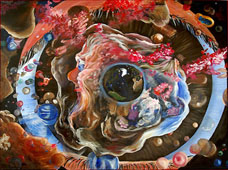 This week in lecture, we learned about how space can be intertwined with art. Space exploration is something that has been a very important topic to many countries for a long time. The space race in the middle of the 20th century was something that was one of the most pivotal events of the time period. The possibilities of what exist in space, as well as what we have discovered so far, is something that has interested me for a long time.
This week in lecture, we learned about how space can be intertwined with art. Space exploration is something that has been a very important topic to many countries for a long time. The space race in the middle of the 20th century was something that was one of the most pivotal events of the time period. The possibilities of what exist in space, as well as what we have discovered so far, is something that has interested me for a long time.  In the lecture, we learned about how humans were not the first people to explore space. Before sending humans, we sent animals such as dogs and monkeys to space to run tests and make sure that people and animals were able to survive.
In the lecture, we learned about how humans were not the first people to explore space. Before sending humans, we sent animals such as dogs and monkeys to space to run tests and make sure that people and animals were able to survive.  Films have been an important way to illustrate space and the many possibilities that are out there. Movies such as Interstellar, Gravity, Star Wars, and other popular movies have played a large role in giving the general public an idea as to the countless possibilities space has to offer, as well as what we have learned from space exploration so far. Overall, there is a great connection between space and art, as expressed through painting, cinematography, and music.
Films have been an important way to illustrate space and the many possibilities that are out there. Movies such as Interstellar, Gravity, Star Wars, and other popular movies have played a large role in giving the general public an idea as to the countless possibilities space has to offer, as well as what we have learned from space exploration so far. Overall, there is a great connection between space and art, as expressed through painting, cinematography, and music.
Beitenu, Likud. "Pigs Jews Monkeys in Space!" Annes Opinions. N.p., 19 Jan. 2013. Web. 29 May 2016.
Boucher, Mark. "Space and Art." - NASA Watch. N.p., n.d. Web. 29 May 2016.
Foust, Jeff. "When Space and Art Intersect." The Space Review:. N.p., n.d. Web. 29 May 2016.
"Outerspace." Outerspace. N.p., n.d. Web. 29 May 2016.
"Space." Space. N.p., n.d. Web. 29 May 2016.












